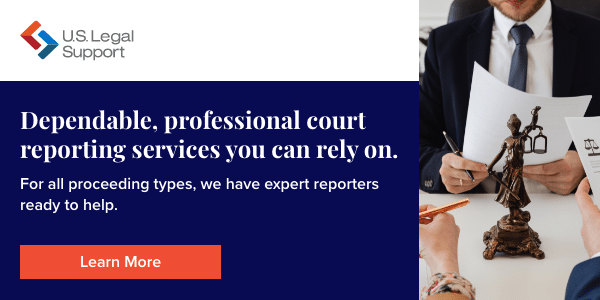What Is Automatic Speech Recognition (ASR)?

Whether it’s automated transcription services or a voice assistant like Siri, automatic speech recognition (ASR) technology has become ubiquitous throughout society. This transformative technology has reshaped how we communicate with machines while simultaneously paving the way for increased accessibility and efficiency.
Tracing its roots back to the invention of the dictation machine by Thomas Edison in 1879, ASR’s journey has been marked by constant innovation, and, in recent years, exponential growth. Now, thanks to the integration of AI and ASR, we’re entering an era of unprecedented possibilities.
But what is automatic speech recognition, exactly? And what impact does it have on the legal system and our society at large?
What Is ASR?
ASR translates spoken language into written text.
Essentially, ASR is a technology that enables humans to speak to their computer, smartphone, or smart device, and for that machine to understand what the speaker is saying, then convert the message into text, often in the form of a command.
Today, the most obvious example of this technology in action would be with smart home devices like Alexa or smartphone assistants like Siri. You simply say their name, followed by a command, and the device responds by performing the action or providing the requested information.
Whether it’s setting a timer, playing a favorite song, providing weather updates, or even controlling smart home features like lighting and thermostats, the underlying ASR technology takes your spoken words and turns them into actionable commands for the device.
But the applications of ASR extend far beyond personal assistants. It’s used in customer service as voice bots to handle inquiries, in legal for transcription services, and in education for accessibility and language learning.
A Brief History of ASR
Throughout ASR history, this technology has evolved and advanced significantly. Although the first instance of ASR was Edison’s dictation machine in 1879, the first real developments after that began in the ‘50s.
- 1950s – Bell Laboratories produces the “Audrey” machine, capable of recognizing digits from 0 to 9.
- 1960s – IBM’s “Shoebox” recognizes 16 English words, and research shifts to expand vocabulary and understand individual speakers.
- 1970s – US DOD develops DARPA Speech Understanding Research (SUR) program to advance speech recognition technology into the realm of sentences.
- 1980s – The introduction of statistical modeling like the Hidden Markov Model (HMM) changes ASR from word recognition and sound patterns to prediction based on phoneme probabilities.
- 1990s – Advances in microprocessor technology allow ASR software to shift from discrete dictation to continuous speech recognition.
- 2000s – Google’s Voice Search and other advancements made speech recognition faster and more accurate.
- 2010s – Digital assistants like Siri, Alexa, and Google Voice become popular, with Google achieving a 95% English word accuracy rate.
- 2020s – Integration of artificial intelligence, machine learning, and deep learning transform ASR capabilities.
How Does ASR Work?
Currently, the pinnacle of ASR is a combination of natural language processing (NLP) and deep learning processing (DLP), which comes the closest to fostering real conversation between humans and machine intelligence.
ASR involves a complex use of advanced algorithms and techniques to perform the most basic of speech-to-text services. This process will often include the following steps:1
- Acoustic capture and analysis – The audio signal (spoken language) is captured, digitized, and broken down into phonemes.
- Language modeling – Phonemes are matched to words using language models. The models predict the likelihood of certain words following others, which helps in recognizing speech patterns.
- Natural Language Processing (NLP) – NLP augments generated transcripts with punctuation and capitalization. Post-processed text is then used for downstream language modeling tasks such as summarization and question-answering.
Benefits and Applications for the Legal Industry
The ripple effects of ASR have spread into practically every modern industry. And the use of artificial intelligence in law is no exception. Whether it’s court reporting or client consultations, the ability to accurately transcribe every detail creates several benefits, including:
- Efficiency and time-saving – ASR technology allows for real-time transcription of spoken language. This enables legal professionals to quickly transcribe meetings, court proceedings, or interviews, saving valuable time that can be used instead for value-add activities.
- Accessibility and convenience – With ASR software, legal documents can be created and edited by voice, making them accessible to those who may have difficulty with traditional typing or writing methods. It’s a practical tool for lawyers on the move, allowing for dictation and transcription even from a mobile device.
- Accuracy – A modern ASR system promises high accuracy levels, and can even understand different accents and dialects. This ensures reliable transcriptions which are vital in a legal setting.
- Cost-effective – ASR can be a more affordable option compared to manual transcription services, especially when dealing with large volumes of audio data.
- Multilingual support – With the capability to recognize various languages, ASR aids in international legal matters, allowing for seamless communication and transcription across different languages.
Thanks to advancements in ASR tech, such as deep learning and natural language processing,
ASR has become an invaluable resource in the legal community, driving efficiency, accuracy, and cost savings. From the law offices to the courtroom, ASR is reshaping the future of legal work.
Sources:
- NVIDIA. Essential Guide to Automatic Speech Recognition Technology. https://developer.nvidia.com/blog/essential-guide-to-automatic-speech-recognition-technology/

Editoral Policy
Content published on the U.S. Legal Support blog is reviewed by professionals in the legal and litigation support services field to help ensure accurate information. The information provided in this blog is for informational purposes only and should not be construed as legal advice for attorneys or clients.


